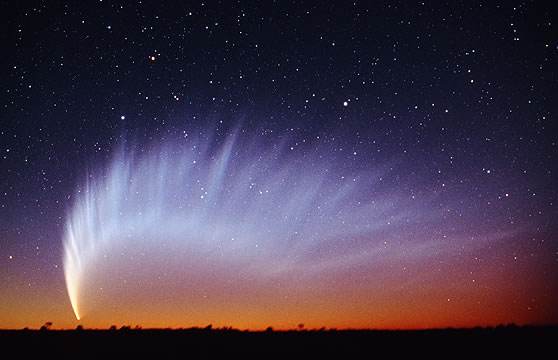Long-Period Comet

Comets with orbital periods longer than 200 years, often with highly elliptical orbits highly inclined to the eclipticPlane of Earth's orbit around the sun. All the planets except Mercury and Pluto have orbits in nearly the same plane. The Sun's axis is tilted at an angle of 7 °15' to the ecliptic, which has been proposed as evidence the Sun was originally part of a binary star system. Click on Term to Read More. These comets probably were perturbed from orbits in the Oort cloudVast spherical swarm ~10-10 long-period comets orbiting the Solar System with semimajor axes between 1,000 and 50,000 AU, typically with low orbital eccentricity. The Oort cloud, while roughly spherical at the largest radius, is wedge-shaped where it merges with the outer planet region in the vicinity of the Kuiper belt Click on Term to Read More by a passing starSelf-luminous object held together by its own self-gravity. Often refers to those objects which generate energy from nuclear reactions occurring at their cores, but may also be applied to stellar remnants such as neutron stars. or giant molecular cloudAn interstellar gas cloud that is dense enough to allow the formation of molecules and comprised of a cold dense complex mixture of interstellar gas and dust roughly 75% hydrogen and 21-24% helium. Clouds contain trace amounts of other molecules, of which well over 100 different types have now been Click on Term to Read More, or by tidal forces generated by the bulge and disk of our GalaxyConcentration of 10 to 10 stars, dust and gas, that are gravitationally bound. Our galaxy contains ~2 × 10 stars. There are four main types of galaxies: • Elliptical
• Lenticular
• Spiral
• Irregular
Click on Term to Read More. The high inclinations of the orbits arise since they can enter the inner Solar SystemThe Sun and set of objects orbiting around it including planets and their moons and rings, asteroids, comets, and meteoroids. from any angle. Long-period comets tend to be the most spectacular comets; because they have not made many (if any) passes through the inner Solar SystemDefinable part of the universe that can be open, closed, or isolated. An open system exchanges both matter and energy with its surroundings. A closed system can only exchange energy with its surroundings; it has walls through which heat can pass. An isolated system cannot exchange energy or matter with, and still retain a large percentage of their initial volatiles. SublimationProcess in which a material changes from a frozen solid to a gas without passing through the liquid state. Whether a material will sublimate, melt, or vaporize depends on the temperature and pressure of its environment. For example, if the pressures are low enough, water ice will turn directly into of these volatiles from the comet nucleusCore of an atom, where nearly the entire mass and all positive charge is concentrated. It consists of protons and neutrons. Click on Term to Read More as it nears the SunOur parent star. The structure of Sun's interior is the result of the hydrostatic equilibrium between gravity and the pressure of the gas. The interior consists of three shells: the core, radiative region, and convective region. Image source: http://eclipse99.nasa.gov/pages/SunActiv.html. The core is the hot, dense central region in which the produces the comaSpherical envelope of gas and dust surrounding the nucleus of an active comet, created when the ambient heat causes the vaporization of comet material. Click on Term to Read More and highly-visible tail. Comets Hale-Bopp (1997), Hyakutake (1996), and McNaught (2007), shown below, were long-period comets.
Some or all content above used with permission from J. H. Wittke.






